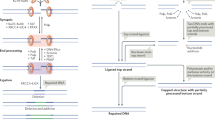Abstract
Chromosomal translocations in lymphoid tumours can involve antigen-receptor loci undergoing V(D)J recombination. Here, we show that translocations are recovered from the joining of RAG-generated double-strand breaks (DSBs) on one chromosome to an endonuclease-generated DSB on a second chromosome, providing evidence for the participation of non-RAG DSBs in some lymphoid translocations. Surprisingly, translocations are increased in cells deficient for the nonhomologous end-joining (NHEJ) protein Ku70, implicating non-canonical joining pathways in their etiology.
This is a preview of subscription content, access via your institution
Access options
Subscribe to this journal
Receive 12 print issues and online access
$209.00 per year
only $17.42 per issue
Buy this article
- Purchase on Springer Link
- Instant access to full article PDF
Prices may be subject to local taxes which are calculated during checkout

Similar content being viewed by others
References
Bassing, C. H., Swat, W. & Alt, F. W. Cell 109, S45–S55 (2002).
Lieber, M. R., Ma, Y., Pannicke, U. & Schwarz, K. Nature Rev. Mol. Cell Biol. 4, 712–720 (2003).
Lieber, M. R., Yu, K. & Raghavan, S. C. DNA Repair 5, 1234–1245 (2006).
Marculescu, R. et al. DNA Repair 5, 1246–1258 (2006).
Weinstock, D. M., Elliott, B. & Jasin, M. Blood 107, 777–780 (2006).
Roth, D. B. Nature Rev. Immunol. 3, 656–666 (2003).
Gu, Y., Jin, S., Gao, Y., Weaver, D. T. & Alt, F. W. Proc. Natl Acad. Sci. USA 94, 8076–8081 (1997).
Liang, F. & Jasin, M. J. Biol. Chem. 271, 14405–14411 (1996).
Verkaik, N. S. et al. Eur. J. Immunol. 32, 701–709 (2002).
Difilippantonio, M. J. et al. J. Exp. Med. 196, 469–480 (2002).
Zhu, C. et al. Cell 109, 811–821 (2002).
Soutoglou, E. et al. Nature Cell Biol. 9, 675–682 (2007).
Acknowledgements
We thank M. Leversha at the Memorial Sloan-Kettering Cancer Centre, Molecular Cytogenetics Core Facility for performing the FISH analysis, and B. Elliott, J. Stark, V. Lee and members of the Jasin laboratory for helpful discussions. D.M.W. was supported by the Leukemia and Lymphoma Society (5415-05) and a Career Award in the Biomedical Sciences from the Burroughs Wellcome Fund. This work was supported by the Lehman Brothers Foundation and National Institutes of Health (NIH) R0154688 (M.J.).
Author information
Authors and Affiliations
Corresponding author
Ethics declarations
Competing interests
The authors declare no competing financial interests.
Supplementary information
Supplementary Information
Supplementary Figure S1, Table S1 and Methods (PDF 969 kb)
Rights and permissions
About this article
Cite this article
Weinstock, D., Brunet, E. & Jasin, M. Formation of NHEJ-derived reciprocal chromosomal translocations does not require Ku70. Nat Cell Biol 9, 978–981 (2007). https://doi.org/10.1038/ncb1624
Received:
Accepted:
Published:
Issue Date:
DOI: https://doi.org/10.1038/ncb1624
This article is cited by
-
The cGAS-Ku80 complex regulates the balance between two end joining subpathways
Cell Death & Differentiation (2024)
-
Ku70 affects the frequency of chromosome translocation in human lymphocytes after radiation and T-cell acute lymphoblastic leukemia
Radiation Oncology (2022)
-
Repair of G1 induced DNA double-strand breaks in S-G2/M by alternative NHEJ
Nature Communications (2020)
-
Regulation of pairing between broken DNA-containing chromatin regions by Ku80, DNA-PKcs, ATM, and 53BP1
Scientific Reports (2017)
-
PARP3 is a promoter of chromosomal rearrangements and limits G4 DNA
Nature Communications (2017)



